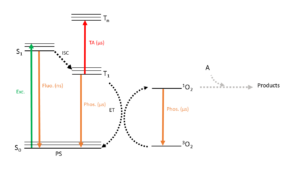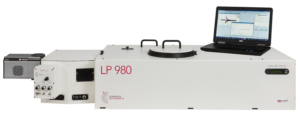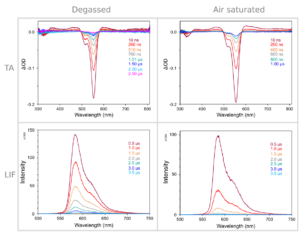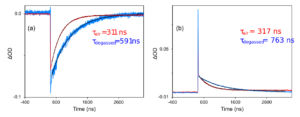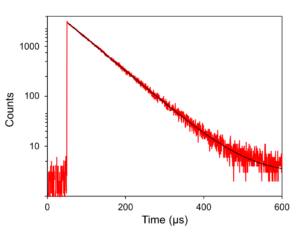Transient Absorption and Singlet Oxygen Phosphorescence of Rose Bengal Photosensitiser
Key Points
- The excited triplet state of the photosensitiser rose bengal is fully characterised by spectral and kinetic transient absorption.
- The kinetics of triplet absorption and delayed fluorescence of rose bengal are shown to depend strongly on the presence of oxygen.
- Time-resolved infrared luminescence of 1O2 can be easily detected in the same spectrometer with a photon-counting upgrade.
Introduction
A photosensitiser (PS) is a chemical species that initiates a reaction upon absorption of light. Photosensitisers vary widely in their chemical composition and practical applications, but they all follow the same mechanism: the PS absorbs light and reaches a triplet excited state. This triplet state, which has a typical lifetime of microseconds, interacts with a target species, transferring energy that induces further reactions. The PS returns to its ground state and can take part in a new photochemical activation.
A widespread application of PSs is the generation of singlet oxygen (1O2) in photodynamic therapy, a treatment for some types of cancer and skin conditions. The PS is introduced to the patient’s body and excited with light into a singlet state, which transitions into a triplet state via intersystem crossing (Figure 1). Energy transfer then takes place between the excited PS and ground-state molecular oxygen (3O2) to generate 1O2. Singlet oxygen is extremely reactive and destroys the target cells, either by direct reaction or by generating oxidised products that react further. The process can be probed by different types of spectroscopy: fluorescence or phosphorescence of the photosensitiser, transient absorption (TA) of the triplet state, and 1O2 phosphorescence.
Figure 1. Jablonski diagram showing excitation of a photosensitiser and singlet oxygen generation. The PS first absorbs light (Exc.) into S1, then undergoes intersystem crossing (ISC) into T1. T1 transfers energy (ET) to 3O2 to generate 1O2, which reacts with other species A to generate photodynamic therapy products.
There is extensive research to find suitable PSs for photodynamic therapy that produce high concentrations of 1O2. The ideal PS molecule yields a high T1 state population upon excitation. In addition, the T1 state should be long-lived and not quenched by species other than 3O2. Optimising the PS requires understanding its triplet formation mechanism, which usually involves characterising the spectrum and lifetime of the T1 state. This is achieved via nanosecond transient absorption (TA), which probes the absorption of T1 as it is excited into higher-lying triplet states (Figure 1). In addition, direct detection of 1O2 is often employed to characterise the yield of energy transfer from T1 to 3O2.
In this application note, an Edinburgh Instruments LP980 Transient Absorption Spectrometer is employed to study the triplet state of rose bengal, a common 1O2 photosensitiser. The same instrument is also used to directly detect 1O2 by laser-induced phosphorescence in the NIR range, eliminating the need for a separate photoluminescence spectrometer.
Materials and Methods
A solution was prepared by dissolving the photosensitiser rose bengal in acetonitrile to an optical density of 0.1 at 510 nm and ~0.5 at 560 nm and loaded into a quartz degassing cuvette. The solution was either saturated with air or degassed by three consecutive freeze-pump-thaw cycles for oxygen-free measurements.
An Edinburgh Instruments LP980 Transient Absorption Spectrometer (Figure 2) was used to study the time-resolved absorption and luminescence of the PS in the visible range. A frequency-doubled Nd:YAG laser (Litron Nano S 130-10) provided 532 nm excitation pulses of 5 – 7 ns with a frequency of 10 Hz. The standard pulsed Xe lamp in the LP980 was used as the probe. Kinetic and spectral data were acquired with a PMT-900 and intensified CCD (ICCD) detector, respectively.
Time-resolved 1O2 phosphorescence was studied in the LP980 with the same pump laser, replacing the visible PMT-900 with an NIR-sensitive PMT-1400 and photon-counting Multichannel Scaling (MCS) electronics.
Figure 2. LP980 Transient Absorption Spectrometer.
TA and Fluorescence Spectra of Rose Bengal
Figure 3 presents TA and fluorescence spectra from rose bengal in acetonitrile. TA spectra measure the absorption from the transient triplet state, while laser-induced fluorescence (LIF) spectra measure photoluminescence emission. Data were acquired for a degassed or air-saturated solution. The presence of oxygen in the air-saturated sample shortens the lifetime of the triplet, which is quenched into its ground state, generating 1O2 at the same time. Such strong dependence of the triplet lifetime on air concentration is characteristic of an efficient PS.
Figure 3. Transient absorption (TA) and fluorescence (LIF) spectra from rose bengal in acetonitrile acquired in an LP980 spectrometer under degassed (left) and air-saturated (right) conditions. Measurement parameters: λpump = 532 nm, Epump = 10 mJ/pulse, Δλprobe = 1 nm, repetition rate = 10 Hz. The delays between ICCD acquisition and pump laser are indicated in the plots.
Without prior knowledge of the PS, the LIF spectra in Figure 3 could be interpreted as phosphorescence from the T1 state. However, the results do not match the phosphorescence spectrum of rose bengal,1 and are identical to its fluorescence spectrum. The luminescence is too long-lived to be prompt fluorescence from the S1 state; besides this, it is quenched by oxygen, suggesting that it arises from a triplet. A potential explanation is delayed fluorescence arising from either triplet-triplet annihilation or reverse intersystem crossing2 upon interaction with 1O2.
TA Decays of Rose Bengal
The triplet relaxation dynamics can be studied in detail with time-resolved TA traces. Figure 4 presents examples using the PMT detector in LP980. Both the negative ground state bleach (a) and the positive TA (b) components of the spectrum are longer lived in the absence of oxygen, confirming the qualitative trend observed in Figure 3.
Figure 4. Transient absorption decays from rose bengal in acetonitrile acquired in LP980 spectrometer at (a) 520 nm and (b) 440 nm under degassed (blue) and air-saturated (red) conditions. Measurement parameters: λpump = 532 nm, Epump = 10 mJ/pulse, Δλprobe = 0.70 nm, repetition rate = 10 Hz. Fit results to a single exponential decay model are shown in the figure.
NIR Phosphorescence Decays of 1O2
Transient absorption of the triplet state provides an insight into the photophysics of the process, and it can be used to screen multiple PS candidates. However, direct detection of singlet oxygen phosphorescence in the NIR remains the best tool for evaluating the PS performance. Such experiments are typically performed in a dedicated photoluminescence spectrometer like the Edinburgh Instruments FLS1000.3 The LP980 removes the need for a separate spectrometer as it can be fitted with a photon-counting NIR PMT and electronics identical to those in FLS1000. This is not only convenient for the user, but it also allows comparison between the TA and NIR phosphorescence datasets with less uncertainty: the same pump laser, sample chamber, and detection monochromator are used so the two experiments are more directly comparable.
A 1O2 phosphorescence decay acquired in the LP980 is shown in Figure 5. The data was acquired in a few minutes thanks to the high sensitivity of the photon-counting NIR PMT detector. The decay fits to a single exponential model with a lifetime of 67 microseconds.
Figure 5. NIR phosphorescence decay from 1O2 acquired in LP980 exciting with 532 nm Nd:YAG laser pulses (laser scatter subtracted from the data) and multichannel scaling detection. The exponential fit result is shown in the graph. Measurement conditions: laser energy = 5 nJ/pulse, repetition rate = 10 Hz, λem = 1275 nm, Δλem = 3 nm, 20 minutes acquisition.
Conclusion
The LP980 Transient Absorption Spectrometer was successfully used to acquire the spectrum and lifetime of the rose Bengal triplet state, as well as visible photoluminescence from rose bengal and NIR phosphorescence from its singlet oxygen product. A complete photophysical characterisation of the photosensitiser and singlet oxygen is possible thanks to the versatile configuration options of the LP980.
References
- Penzkofer et al., Room temperature phosphorescence lifetime and quantum yield of erythrosine B and rose Bengal in aerobic alkaline aqueous solution, J. Lumin., 2012, 132, 1055-1062
- Scholz et al., Singlet oxygen-sensitized delayed fluorescence of common water-soluble photosensitizers, Photochem. Photobiol. Sci., 2013, 12, 1873-1884
- Tesa, Maria. Detection of Singlet Oxygen by Photoluminescence Spectroscopy, Edinburgh Instrument Application Note AN_P85, 2023









